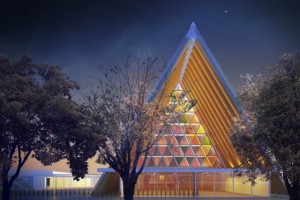 New York – A new architectural wonder was unveiled in Christchurch, New Zealand this week. Though grand, its delight lies more in its underlying simplicity.
New York – A new architectural wonder was unveiled in Christchurch, New Zealand this week. Though grand, its delight lies more in its underlying simplicity.
In a world of news flooded with oppressive tragedy and disorder, from the violent decline of Egypt to the abuse of power by the surveillance obsessed governments of England and the United States, it is a delight and a relief to read of any bright news that shows visionary, humanitarian horizons of human nature, human creativity, and purposes built on care.
On August 11, parishioners of the Anglican Diocese of Christchurch who lost their 131-year-old Gothic Christchurch Cathedral to a 6.3 magnitude earthquake in February, 2011, gathered once again to worship all together – in a cardboard church.
This “cardboard church” in reality is the instantly world famous Transitional Cathedral, an architectural wonder designed by Shigeru Ban” whom HufPo calls “none other than disaster relief housing specialist, environmentalist, and cardboard building proselytizer, and lauded “emergency architect.”
On August 15, 100s gathered for the dedication service of the new cathedral led by the Bishop of Christchurch, Victoria Matthews.
Many of us remember the poignant, 2011 photograph of Bishop Matthews standing across from the rubble that was once the historic Christchurch Cathedral.
This Thursday however the devoted Bishop was seen quite differently. According to Radio New Zealand Bishop Matthews, though having visited the cathedral several times when it was a construction site, she was not prepared for her reaction the first time she saw it set up as a church.
The beautiful Cathedral, with a capacity for 700 worshippers, built from 98 polyurethane and flame retardant-coated cardboard beams, due to its translucent polycarbonate roof radiates light from within when lit for services. The front arch, made up of striking triangular stained glass windows etched with images from the original cathedral’s rose window, glows with great beauty.
“The tears came to my eyes,” admitted Bishop Matthews, “I really had a hard time keeping control because it was just so powerful.”
As pastor to a community struck by devastation and disaster, she had to embrace and counsel the bereaved, while at the same time withstand the loss of her own sacred home, such a reaction is understandable. “She says it is very special to have the empty chair memorial to the 185 earthquake victims and the site of the CTV building close by.”
But why cardboard?
In his Guardian interview, Shigeru Ban, who studied studied under John Hejduk of the “New York Five,” at Cooper Union’s School of Architecture said, “Buildings made of concrete are easily destroyed by earthquakes, but paper-tube buildings can survive without damage.” Won’t the cardboard go soggy in the rain? Won’t it catch fire? thought the interviewer with the same question as us all, “I didn’t need to ask if it was strong enough: we were sitting in a studio he had built on top of the Pompidou Centre in Paris – out of cardboard tubes.”
This Cathedral Cathedral is 100 percent up to earthquake code. “The strength of the building has nothing to do with the strength of the material,” says Ban, “even concrete buildings can be destroyed by earthquakes very easily. But paper buildings cannot be destroyed by earthquakes.” It will last at least 50 years.
In Ban’s view, “a building’s lifetime doesn’t depend on what it’s made from, but how much it’s loved. If a building is valued, it’s looked after, restored, repaired, it will last.”
What brought Ban to this Cathedral project was his long history of investing in human need arising at sites of natural and humanitarian disasters, such as his work in Turkey in 1999, during the Rwanda refugee crisis in 1994, and the after the 7.2 Richter scale earthquake that devastated Kobe Japan that same year. Recently Ban was involved Tohoku region of northeastern Honshu where in the aftermath of the Great East Japan Earthquake of March 11, 2011, he designed partition systems again from cardboard tubes to serve the residents of evacuation centers.
Similarly, Christchurch’s original stone-built Cathedral was destroyed in the February 2011 earthquake disaster.
Could this be the moment when at last, the rest of the world pays attention? “In many ways, cardboard is the perfect building material,” insists Ban, “It’s environmentally low-impact; it’s virtually a waste product; it’s easy to manufacture; it has good insulating properties, an attractive texture, and it’s cheap.”
